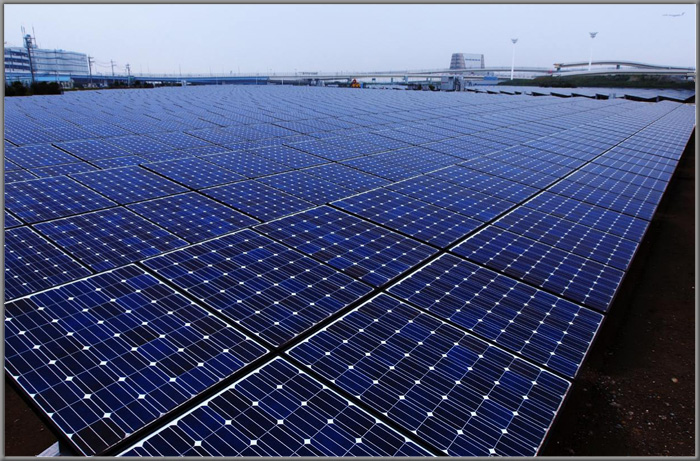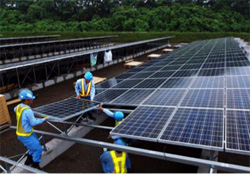Home > Highlighting JAPAN > Highlighting Japan JULY 2011 > Embracing New Energy
Highlighting JAPAN
COVER STORY: Embracing New Energy
Caption: The Mega Solar power generation project is close to completion on Ukishima island off Kawasaki, Kanagawa Prefecture.
Credit: TADASHI AIZAWA
Embracing New Energy

Workers assemble solar panels on Ogijima island off Kawasaki, Kanagawa Prefecture.
Credit: TADASHI AIZAWA
In a speech that he made at the 50th Ministerial Meeting of the OECD (Organization for Economic Cooperation and Development) held at the OECD headquarters on May 25, Prime Minister Naoto Kan said that the government would review Japan's basic energy plan and would take on four challenges: the safety of nuclear energy, the environmental challenge of fossil fuels—that is, minimizing emissions of carbon dioxide (CO2)—the practical use of renewable energy, and the potential of energy efficiency.
In association with the practical use of renewable energy, he said Japan would engage in drastic technological innovation in order to increase the share of renewable energy in total electric power supply to at least go beyond 20 percent by the earliest possible in the 2020s. As a first step for this purpose, Japan aims to lower the cost of solar power generation to one third of its current level by 2020 and to one sixth by 2030. Moreover, Japan aim to equip solar panels on all the roofs of 10 million houses capable of doing so.
A large solar energy generation project, named the Mega Solar power generation project, is underway in Ukishima and Ogishima, two artificial islands off the coast off Kawasaki, Kanagawa Prefecture, next to Tokyo. A solar plant occupying around 11 hectares on Ukishima is slated to start operation in August. The plant will be able to produce about 7,000 kW. A solar plant that will be able to generate about 13,000 kW is scheduled to start operation on a plot of about 23 hectares on Ogishima in December. When completed, the two solar plants combined will become one of the largest mega large solar plants in Japan in terms of electric generating capacity.
To date, the Federation of Electric Power Companies of Japan has announced plans to construct huge solar plants in thirty places nationwide, including Kawasaki, with the capacity to generate about 140,000 kW in total. The electricity is equivalent to electricity used in about 40,000 households and will contribute to a reduction of about 70,000 tons of CO2 (Some power plants have already started operation.)
"Environmental learning facilities will be established next to the Mega Solar on Ukishima. People will be able to see the Mega Solar from there," said a Kawasaki city official in charge of the project. "Nowhere else in the Tokyo area can a solar plant of this size be seen from such a short distance. We hope many people will study the mechanism of Mega Solar and will feel closer to solar energy generation."
Japan has started to take on challenges relating to next-generation energy, including solar energy, in a range of forms. Our feature in this issue introduces some of the most recent examples.
© 2009 Cabinet Office, Government of Japan






